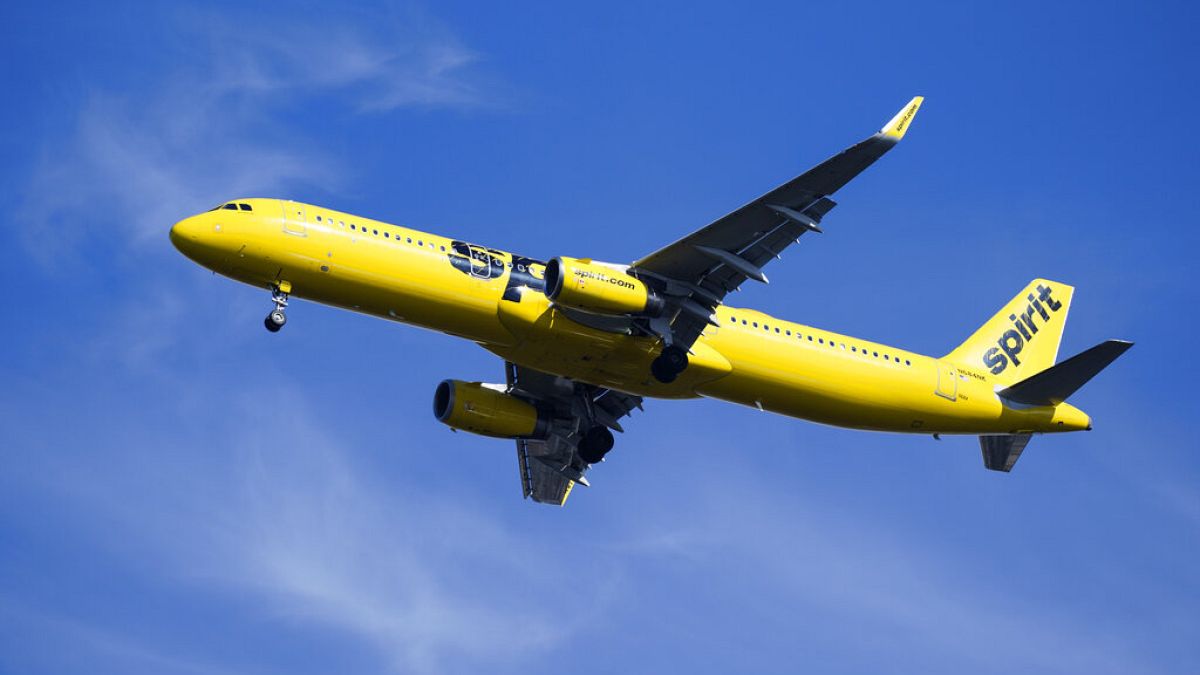The budget travel firm was hit hard by the pandemic and a failed merger, leading to mounting losses in recent years.
Spirit Airlines has filed for bankruptcy protection as its financial woes deepen, the company announced on Monday.
The US’s largest budget airline has lost more than $2.5bn (€2.4bn) since the start of 2020.
According to a court document, it has listed assets and liabilities in the range of between $1bn (€950m) and $10bn (€9.5bn).
Spirit said it expects to operate as normal as it works its way through a prearranged Chapter 11 bankruptcy process, meaning that customers can continue to book and fly without interruption.
“The most important thing to know is that you can continue to book and fly now and in the future,” Spirit CEO Ted Christie said in a letter to customers on Monday.
The firm explained in a separate statement that it had reached an agreement on debt restructuring with its bondholders.
These bondholders will provide $350m (€332m) of fresh equity and $300m (€284m) of debtor-in-possession financing.
A slow decline
Shares of Spirit dropped 25% last Friday after The Wall Street Journal reported that the airline was discussing terms of a possible bankruptcy filing with its bondholders.
It was just the latest in a series of blows that have sent the stock crashing down by 97% since late 2018 – when Spirit was still making money.
CEO Ted Christie confirmed in August that Spirit was talking to advisers of its bondholders about the upcoming debt maturities. He called the discussions a priority, and said the airline was trying to get the best deal it could as quickly as possible.
“The chatter in the market about Spirit is notable, but we are not distracted,” he told investors during an earnings call.
“We are focused on refinancing our debt, improving our overall liquidity position, deploying our new reimagined product into the market, and growing our loyalty programs.”
People are still flying on Spirit Airlines, but they’re just not paying as much.
In the first six months of this year, Spirit passengers flew 2% more than they did in the same period last year.
However, they are paying 10% less per mile, and revenue per mile from fares is down nearly 20%, contributing to Spirit’s deficit.
Pandemic-era losses and fierce competition
Due to a variety of reasons, Spirit failed to return to profitability when the coronavirus pandemic eased and travel rebounded.
Spirit’s costs, especially for labour, have risen, while the biggest US airlines have also snagged some of Spirit’s budget-conscious customers with rival deals.
Fares for US leisure travel, Spirit’s core business, have sagged because of a glut of new flights.
The premium end of the air-travel market has surged while Spirit’s traditional no-frills end has stagnated.
This summer, Spirit decided to divert from its original strategy and sell bundled fares. These tickets include a bigger seat, priority boarding, free bags, internet service and snacks and drinks.
Cuts to flight schedules
In a highly unusual move, Spirit plans to cut its October to December schedule by nearly 20%, compared with the same period last year, which analysts say should help prop up fares.
This move could, however, help rivals more than it will boost Spirit.
Analysts from Deutsche Bank and Raymond James say that Frontier, JetBlue and Southwest would benefit the most because of their overlap with Spirit on many routes.
Failed JetBlue merger
Spirit’s financial woes can also be blamed on a failed merger with the airline JetBlue.
The US Department of Justice sued to block the $3.8bn (€3.6bn) deal, saying it would drive up prices for Spirit customers who depend on low fares, and a federal judge agreed in January.
JetBlue and Spirit dropped their merger plans two months later.
US airline bankruptcies were common in the 1990s and 2000s, as airlines struggled with fierce competition, high labour costs and sudden spikes in the price of jet fuel.
PanAm, TWA, Northwest, Continental, United and Delta were swept up.
Some went into liquidation, while others used favourable laws to renegotiate debts such as aircraft leases and keep flying.
The last bankruptcy by a major US carrier ended when American Airlines emerged from Chapter 11 protection and simultaneously merged with US Airways in December 2013.

